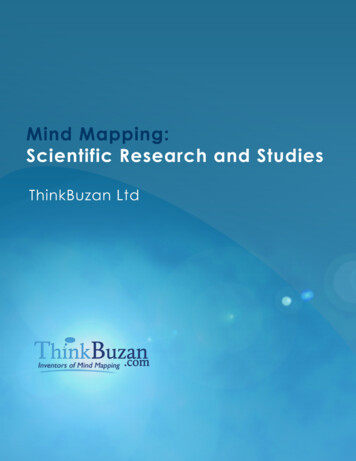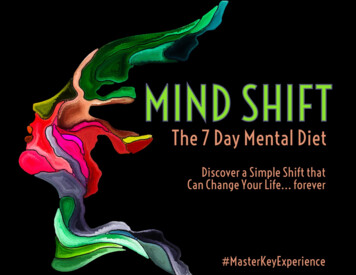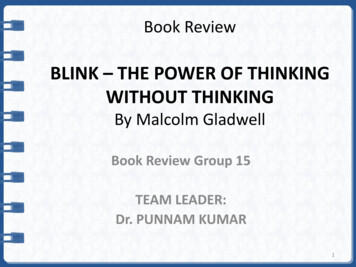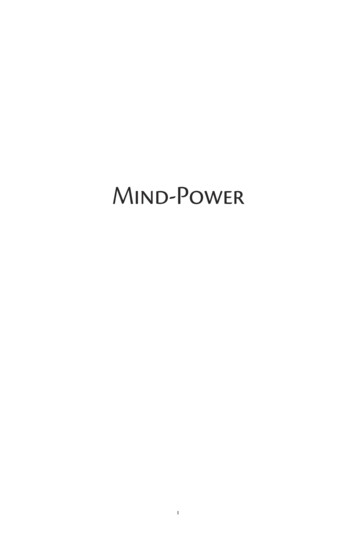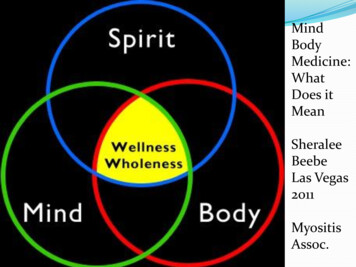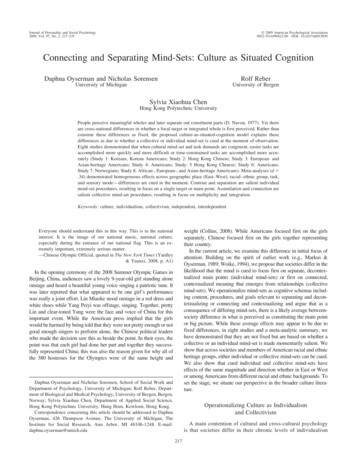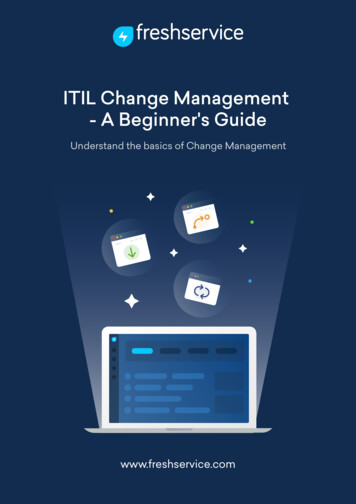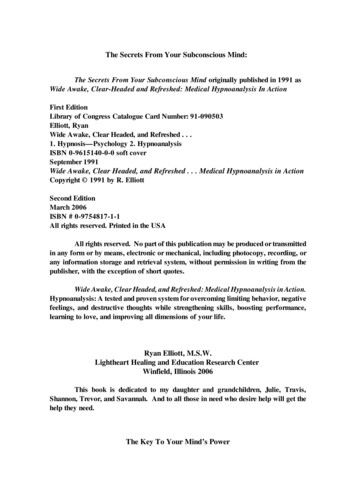
Transcription
ALSO BYMichael PollanCookedFood RulesIn Defense of FoodThe Omnivore’s DilemmaThe Botany of DesireA Place of My OwnSecond Nature
PENGUIN PRESSAn imprint of Penguin Random House LLC375 Hudson StreetNew York, New York 10014penguin.comCopyright 2018 by Michael PollanPenguin supports copyright. Copyright fuels creativity, encourages diverse voices, promotes free speech, and creates avibrant culture. Thank you for buying an authorized edition of this book and for complying with copyright laws by notreproducing, scanning, or distributing any part of it in any form without permission. You are supporting writers andallowing Penguin to continue to publish books for every reader.Image here and here from “Homological scaffolds of brain functional networks,” by G. Petri, P. Expert, F. Turkheimer, R.Carhart-Harris, D. Nutt, P. J. Hellyer, and F. Vaccarino, Journal of the Royal Society Interface, 2014.LIBRARY OF CONGRESS CATALOGING-IN-PUBLICATION DATANames: Pollan, Michael, 1955– author.Title: How to change your mind : what the new science of psychedelics teaches us about consciousness, dying, addiction,depression, and transcendence / Michael Pollan.Description: New York : Penguin Press, 2018.Identifiers: LCCN 2018006190 (print) LCCN 2018010396 (ebook) ISBN 9780525558941 (ebook) ISBN9781594204227 (hardback)Subjects: LCSH: Pollan, Michael, 1955—Mental health. Hallucinogenic drugs—Therapeutic use. Psychotherapy patients—Biography. BISAC: BIOGRAPHY & AUTOBIOGRAPHY / Science & Technology. MEDICAL / Mental Health.Classification: LCC RM324.8 (ebook) LCC RM324.8 .P65 2018 (print) DDC 615.7/883—dc23LC record available at https://lccn.loc.gov/2018006190NOTE: This book relates the author’s investigative reporting on, and related self-experimentation with, psilocybinmushrooms, the drug lysergic acid diethylamide (or, as it is more commonly known, LSD), and the drug 5-methoxy-N,Ndimethyltryptamine (more commonly known as 5-MeO-DMT or The Toad). It is a criminal offense in the United Statesand in many other countries, punishable by imprisonment and/or fines, to manufacture, possess, or supply LSD,psilocybin mushrooms, and/or the drug 5-MeO-DMT, except in connection with government-sanctioned research. Youshould therefore understand that this book is intended to convey the author’s experiences and to provide an understandingof the background and current state of research into these substances. It is not intended to encourage you to break the lawand no attempt should be made to use these substances for any purpose except in a legally sanctioned clinical trial. Theauthor and the publisher expressly disclaim any liability, loss, or risk, personal or otherwise, that is incurred as aconsequence, directly or indirectly, of the contents of this book.Certain names and locations have been changed in order to protect the author and others.Version 1
For my father
The soul should always stand ajar.—EMILY DICKINSON
ContentsAlso by Michael PollanTitle PageCopyrightDedicationEpigraphPrologue: A New DoorCHAPTER ONEA RenaissanceCHAPTER TWONatural History: BemushroomedCodaCHAPTER THREEHistory: The First WavePart I: The PromisePart II: The Crack-UpCodaCHAPTER FOURTravelogue: Journeying UndergroundTrip One: LSDTrip Two: PsilocybinTrip Three: 5-MeO-DMT (or, The Toad)CHAPTER FIVEThe Neuroscience: Your Brain on PsychedelicsCHAPTER SIXThe Trip Treatment: Psychedelics in PsychotherapyOne: DyingTwo: Addiction
Three: DepressionCoda: Going to Meet My Default Mode NetworkEpilogue: In Praise of Neural ndexAbout the Author
PROLOGUEA New DoorMIDWAY THROUGH the twentieth century, two unusual new molecules,organic compounds with a striking family resemblance, exploded uponthe West. In time, they would change the course of social, political, andcultural history, as well as the personal histories of the millions of peoplewho would eventually introduce them to their brains. As it happened, thearrival of these disruptive chemistries coincided with another worldhistorical explosion—that of the atomic bomb. There were people whocompared the two events and made much of the cosmic synchronicity.Extraordinary new energies had been loosed upon the world; thingswould never be quite the same.The first of these molecules was an accidental invention of science.Lysergic acid diethylamide, commonly known as LSD, was firstsynthesized by Albert Hofmann in 1938, shortly before physicists split anatom of uranium for the first time. Hofmann, who worked for the Swisspharmaceutical firm Sandoz, had been looking for a drug to stimulatecirculation, not a psychoactive compound. It wasn’t until five years laterwhen he accidentally ingested a minuscule quantity of the new chemicalthat he realized he had created something powerful, at once terrifyingand wondrous.The second molecule had been around for thousands of years, thoughno one in the developed world was aware of it. Produced not by a chemistbut by an inconspicuous little brown mushroom, this molecule, whichwould come to be known as psilocybin, had been used by the indigenouspeoples of Mexico and Central America for hundreds of years as asacrament. Called teonanácatl by the Aztecs, or “flesh of the gods,” themushroom was brutally suppressed by the Roman Catholic Church afterthe Spanish conquest and driven underground. In 1955, twelve years after
Albert Hofmann’s discovery of LSD, a Manhattan banker and amateurmycologist named R. Gordon Wasson sampled the magic mushroom inthe town of Huautla de Jiménez in the southern Mexican state of Oaxaca.Two years later, he published a fifteen-page account of the “mushroomsthat cause strange visions” in Life magazine, marking the moment whennews of a new form of consciousness first reached the general public. (In1957, knowledge of LSD was mostly confined to the community ofresearchers and mental health professionals.) People would not realizethe magnitude of what had happened for several more years, but historyin the West had shifted.The impact of these two molecules is hard to overestimate. The adventof LSD can be linked to the revolution in brain science that begins in the1950s, when scientists discovered the role of neurotransmitters in thebrain. That quantities of LSD measured in micrograms could producesymptoms resembling psychosis inspired brain scientists to search for theneurochemical basis of mental disorders previously believed to bepsychological in origin. At the same time, psychedelics found their wayinto psychotherapy, where they were used to treat a variety of disorders,including alcoholism, anxiety, and depression. For most of the 1950s andearly 1960s, many in the psychiatric establishment regarded LSD andpsilocybin as miracle drugs.The arrival of these two compounds is also linked to the rise of thecounterculture during the 1960s and, perhaps especially, to its particulartone and style. For the first time in history, the young had a rite ofpassage all their own: the “acid trip.” Instead of folding the young into theadult world, as rites of passage have always done, this one landed them ina country of the mind few adults had any idea even existed. The effect onsociety was, to put it mildly, disruptive.Yet by the end of the 1960s, the social and political shock wavesunleashed by these molecules seemed to dissipate. The dark side ofpsychedelics began to receive tremendous amounts of publicity—badtrips, psychotic breaks, flashbacks, suicides—and beginning in 1965 theexuberance surrounding these new drugs gave way to moral panic. Asquickly as the culture and the scientific establishment had embracedpsychedelics, they now turned sharply against them. By the end of thedecade, psychedelic drugs—which had been legal in most places—were
outlawed and forced underground. At least one of the twentieth century’stwo bombs appeared to have been defused.Then something unexpected and telling happened. Beginning in the1990s, well out of view of most of us, a small group of scientists,psychotherapists, and so-called psychonauts, believing that somethingprecious had been lost from both science and culture, resolved to recoverit.Today, after several decades of suppression and neglect, psychedelicsare having a renaissance. A new generation of scientists, many of theminspired by their own personal experience of the compounds, are testingtheir potential to heal mental illnesses such as depression, anxiety,trauma, and addiction. Other scientists are using psychedelics inconjunction with new brain-imaging tools to explore the links betweenbrain and mind, hoping to unravel some of the mysteries ofconsciousness.One good way to understand a complex system is to disturb it and thensee what happens. By smashing atoms, a particle accelerator forces themto yield their secrets. By administering psychedelics in carefullycalibrated doses, neuroscientists can profoundly disturb the normalwaking consciousness of volunteers, dissolving the structures of the selfand occasioning what can be described as a mystical experience. Whilethis is happening, imaging tools can observe the changes in the brain’sactivity and patterns of connection. Already this work is yieldingsurprising insights into the “neural correlates” of the sense of self andspiritual experience. The hoary 1960s platitude that psychedelics offereda key to understanding—and “expanding”—consciousness no longer looksquite so preposterous.How to Change Your Mind is the story of this renaissance. Although itdidn’t start out that way, it is a very personal as well as public history.Perhaps this was inevitable. Everything I was learning about the thirdperson history of psychedelic research made me want to explore thisnovel landscape of the mind in the first person too—to see how thechanges in consciousness these molecules wrought actually feel and what,if anything, they had to teach me about my mind and might contribute tomy life.
THIS WAS, FOR ME, a completely unexpected turn of events. The history ofpsychedelics I’ve summarized here is not a history I lived. I was born in1955, halfway through the decade that psychedelics first burst onto theAmerican scene, but it wasn’t until the prospect of turning sixty haddrifted into view that I seriously considered trying LSD for the first time.Coming from a baby boomer, that might sound improbable, a derelictionof generational duty. But I was only twelve years old in 1967, too young tohave been more than dimly aware of the Summer of Love or the SanFrancisco Acid Tests. At fourteen, the only way I was going to get toWoodstock was if my parents drove me. Much of the 1960s I experiencedthrough the pages of Time magazine. By the time the idea of trying or nottrying LSD swam into my conscious awareness, it had already completedits speedy media arc from psychiatric wonder drug to counterculturesacrament to destroyer of young minds.I must have been in junior high school when a scientist reported(mistakenly, as it turned out) that LSD scrambled your chromosomes; theentire media, as well as my health-ed teacher, made sure we heard allabout it. A couple of years later, the television personality Art Linkletterbegan campaigning against LSD, which he blamed for the fact hisdaughter had jumped out of an apartment window, killing herself. LSDsupposedly had something to do with the Manson murders too. By theearly 1970s, when I went to college, everything you heard about LSDseemed calculated to terrify. It worked on me: I’m less a child of thepsychedelic 1960s than of the moral panic that psychedelics provoked.I also had my own personal reason for steering clear of psychedelics: apainfully anxious adolescence that left me (and at least one psychiatrist)doubting my grip on sanity. By the time I got to college, I was feelingsturdier, but the idea of rolling the mental dice with a psychedelic drugstill seemed like a bad idea.Years later, in my late twenties and feeling more settled, I did trymagic mushrooms two or three times. A friend had given me a Mason jarfull of dried, gnarly Psilocybes, and on a couple of memorable occasionsmy partner (now wife), Judith, and I choked down two or three of them,endured a brief wave of nausea, and then sailed off on four or fiveinteresting hours in the company of each other and what felt like awonderfully italicized version of the familiar reality.
Psychedelic aficionados would probably categorize what we had as alow-dose “aesthetic experience,” rather than a full-blown egodisintegrating trip. We certainly didn’t take leave of the known universeor have what anyone would call a mystical experience. But it was reallyinteresting. What I particularly remember was the preternaturalvividness of the greens in the woods, and in particular the velvetychartreuse softness of the ferns. I was gripped by a powerful compulsionto be outdoors, undressed, and as far from anything made of metal orplastic as it was possible to get. Because we were alone in the country,this was all doable. I don’t recall much about a follow-up trip on aSaturday in Riverside Park in Manhattan except that it was considerablyless enjoyable and unselfconscious, with too much time spent wonderingif other people could tell that we were high.I didn’t know it at the time, but the difference between these twoexperiences of the same drug demonstrated something important, andspecial, about psychedelics: the critical influence of “set” and “setting.”Set is the mind-set or expectation one brings to the experience, andsetting is the environment in which it takes place. Compared with otherdrugs, psychedelics seldom affect people the same way twice, becausethey tend to magnify whatever’s already going on both inside and outsideone’s head.After those two brief trips, the mushroom jar lived in the back of ourpantry for years, untouched. The thought of giving over a whole day to apsychedelic experience had come to seem inconceivable. We wereworking long hours at new careers, and those vast swaths of unallocatedtime that college (or unemployment) affords had become a memory. Nowanother, very different kind of drug was available, one that wasconsiderably easier to weave into the fabric of a Manhattan career:cocaine. The snowy-white powder made the wrinkled brown mushroomsseem dowdy, unpredictable, and overly demanding. Cleaning out thekitchen cabinets one weekend, we stumbled upon the forgotten jar andtossed it in the trash, along with the exhausted spices and expiredpackages of food.Fast-forward three decades, and I really wish I hadn’t done that. I’dgive a lot to have a whole jar of magic mushrooms now. I’ve begun towonder if perhaps these remarkable molecules might be wasted on theyoung, that they may have more to offer us later in life, after the cement
of our mental habits and everyday behaviors has set. Carl Jung oncewrote that it is not the young but people in middle age who need to havean “experience of the numinous” to help them negotiate the second halfof their lives.By the time I arrived safely in my fifties, life seemed to be runningalong a few deep but comfortable grooves: a long and happy marriagealongside an equally long and gratifying career. As we do, I had developeda set of fairly dependable mental algorithms for navigating whatever lifethrew at me, whether at home or at work. What was missing from mylife? Nothing I could think of—until, that is, word of the new research intopsychedelics began to find its way to me, making me wonder if perhaps Ihad failed to recognize the potential of these molecules as a tool for bothunderstanding the mind and, potentially, changing it. HERE ARE THE THREE DATA POINTS that persuaded me this was the case.In the spring of 2010, a front-page story appeared in the New YorkTimes headlined “Hallucinogens Have Doctors Tuning In Again.” Itreported that researchers had been giving large doses of psilocybin—theactive compound in magic mushrooms—to terminal cancer patients as away to help them deal with their “existential distress” at the approach ofdeath.These experiments, which were taking place simultaneously at JohnsHopkins, UCLA, and New York University, seemed not just improbablebut crazy. Faced with a terminal diagnosis, the very last thing I wouldwant to do is take a psychedelic drug—that is, surrender control of mymind and then in that psychologically vulnerable state stare straight intothe abyss. But many of the volunteers reported that over the course of asingle guided psychedelic “journey” they reconceived how they viewedtheir cancer and the prospect of dying. Several of them said they had losttheir fear of death completely. The reasons offered for thistransformation were intriguing but also somewhat elusive. “Individualstranscend their primary identification with their bodies and experienceego-free states,” one of the researchers was quoted as saying. They“return with a new perspective and profound acceptance.”
I filed that story away, until a year or two later, when Judith and Ifound ourselves at a dinner party at a big house in the Berkeley Hills,seated at a long table with a dozen or so people, when a woman at the farend of the table began talking about her acid trips. She looked to be aboutmy age and, I learned, was a prominent psychologist. I was engrossed in adifferent conversation at the time, but as soon as the phonemes L-S-Ddrifted down to my end of the table, I couldn’t help but cup my ear(literally) and try to tune in.At first, I assumed she was dredging up some well-polished anecdotefrom her college days. Not the case. It soon became clear that the acid tripin question had taken place only days or weeks before, and in fact wasone of her first. The assembled eyebrows rose. She and her husband, aretired software engineer, had found the occasional use of LSD bothintellectually stimulating and of value to their work. Specifically, thepsychologist felt that LSD gave her insight into how young childrenperceive the world. Kids’ perceptions are not mediated by expectationsand conventions in the been-there, done-that way that adult perceptionis; as adults, she explained, our minds don’t simply take in the world as itis so much as they make educated guesses about it. Relying on theseguesses, which are based on past experience, saves the mind time andenergy, as when, say, it’s trying to figure out what that fractal pattern ofgreen dots in its visual field might be. (The leaves on a tree, probably.)LSD appears to disable such conventionalized, shorthand modes ofperception and, by doing so, restores a childlike immediacy, and sense ofwonder, to our experience of reality, as if we were seeing everything forthe first time. (Leaves!)I piped up to ask if she had any plans to write about these ideas, whichriveted everyone at the table. She laughed and gave me a look that I tookto say, How naive can you be? LSD is a schedule 1 substance, meaningthe government regards it as a drug of abuse with no accepted medicaluse. Surely it would be foolhardy for someone in her position to suggest,in print, that psychedelics might have anything to contribute tophilosophy or psychology—that they might actually be a valuable tool forexploring the mysteries of human consciousness. Serious research intopsychedelics had been more or less purged from the university fifty yearsago, soon after Timothy Leary’s Harvard Psilocybin Project crashed and
burned in 1963. Not even Berkeley, it seemed, was ready to go thereagain, at least not yet.Third data point: The dinner table conversation jogged a vaguememory that a few years before somebody had e-mailed me a scientificpaper about psilocybin research. Busy with other things at the time, Ihadn’t even opened it, but a quick search of the term “psilocybin”instantly fished the paper out of the virtual pile of discarded e-mail on mycomputer. The paper had been sent to me by one of its co-authors, a manI didn’t know by the name of Bob Jesse; perhaps he had read somethingI’d written about psychoactive plants and thought I might be interested.The article, which was written by the same team at Hopkins that wasgiving psilocybin to cancer patients, had just been published in thejournal Psychopharmacology. For a peer-reviewed scientific paper, ithad a most unusual title: “Psilocybin Can Occasion Mystical-TypeExperiences Having Substantial and Sustained Personal Meaning andSpiritual Significance.”Never mind the word “psilocybin”; it was the words “mystical” and“spiritual” and “meaning” that leaped out from the pages of apharmacology journal. The title hinted at an intriguing frontier ofresearch, one that seemed to straddle two worlds we’ve grownaccustomed to think are irreconcilable: science and spirituality.Now I fell on the Hopkins paper, fascinated. Thirty volunteers whohad never before used psychedelics had been given a pill containingeither a synthetic version of psilocybin or an “active placebo”—methylphenidate, or Ritalin—to fool them into thinking they had receivedthe psychedelic. They then lay down on a couch wearing eyeshades andlistening to music through headphones, attended the whole time by twotherapists. (The eyeshades and headphones encourage a more inwardfocused journey.) After about thirty minutes, extraordinary things beganto happen in the minds of the people who had gotten the psilocybin pill.The study demonstrated that a high dose of psilocybin could be used tosafely and reliably “occasion” a mystical experience—typically describedas the dissolution of one’s ego followed by a sense of merging with natureor the universe. This might not come as news to people who takepsychedelic drugs or to the researchers who first studied them back in the1950s and 1960s. But it wasn’t at all obvious to modern science, or to me,in 2006, when the paper was published.
What was most remarkable about the results reported in the article isthat participants ranked their psilocybin experience as one of the mostmeaningful in their lives, comparable “to the birth of a first child or deathof a parent.” Two-thirds of the participants rated the session among thetop five “most spiritually significant experiences” of their lives; one-thirdranked it the most significant such experience in their lives. Fourteenmonths later, these ratings had slipped only slightly. The volunteersreported significant improvements in their “personal well-being, lifesatisfaction and positive behavior change,” changes that were confirmedby their family members and friends.Though no one knew it at the time, the renaissance of psychedelicresearch now under way began in earnest with the publication of thatpaper. It led directly to a series of trials—at Hopkins and several otheruniversities—using psilocybin to treat a variety of indications, includinganxiety and depression in cancer patients, addiction to nicotine andalcohol, obsessive-compulsive disorder, depression, and eating disorders.What is striking about this whole line of clinical research is the premisethat it is not the pharmacological effect of the drug itself but the kind ofmental experience it occasions—involving the temporary dissolution ofone’s ego—that may be the key to changing one’s mind. AS SOMEONE not at all sure he has ever had a single “spiritually significant”experience, much less enough of them to make a ranking, I found that the2006 paper piqued my curiosity but also my skepticism. Many of thevolunteers described being given access to an alternative reality, a“beyond” where the usual physical laws don’t apply and variousmanifestations of cosmic consciousness or divinity present themselves asunmistakably real.All this I found both a little hard to take (couldn’t this be just a druginduced hallucination?) and yet at the same time intriguing; part of mewanted it to be true, whatever exactly “it” was. This surprised me, becauseI have never thought of myself as a particularly spiritual, much lessmystical, person. This is partly a function of worldview, I suppose, andpartly of neglect: I’ve never devoted much time to exploring spiritual
paths and did not have a religious upbringing. My default perspective isthat of the philosophical materialist, who believes that matter is thefundamental substance of the world and the physical laws it obeys shouldbe able to explain everything that happens. I start from the assumptionthat nature is all that there is and gravitate toward scientific explanationsof phenomena. That said, I’m also sensitive to the limitations of thescientific-materialist perspective and believe that nature (including thehuman mind) still holds deep mysteries toward which science cansometimes seem arrogant and unjustifiably dismissive.Was it possible that a single psychedelic experience—something thatturned on nothing more than the ingestion of a pill or square of blotterpaper—could put a big dent in such a worldview? Shift how one thoughtabout mortality? Actually change one’s mind in enduring ways?The idea took hold of me. It was a little like being shown a door in afamiliar room—the room of your own mind—that you had somehownever noticed before and being told by people you trusted (scientists!)that a whole other way of thinking—of being!—lay waiting on the otherside. All you had to do was turn the knob and enter. Who wouldn’t becurious? I might not have been looking to change my life, but the idea oflearning something new about it, and of shining a fresh light on this oldworld, began to occupy my thoughts. Maybe there was somethingmissing from my life, something I just hadn’t named.Now, I already knew something about such doors, having writtenabout psychoactive plants earlier in my career. In The Botany of Desire, Iexplored at some length what I had been surprised to discover is auniversal human desire to change consciousness. There is not a cultureon earth (well, one*) that doesn’t make use of certain plants to change thecontents of the mind, whether as a matter of healing, habit, or spiritualpractice. That such a curious and seemingly maladaptive desire shouldexist alongside our desires for nourishment and beauty and sex—all ofwhich make much more obvious evolutionary sense—cried out for anexplanation. The simplest was that these substances help relieve pain andboredom. Yet the powerful feelings and elaborate taboos and rituals thatsurround many of these psychoactive species suggest there must besomething more to it.For our species, I learned, plants and fungi with the power to radicallyalter consciousness have long and widely been used as tools for healing
the mind, for facilitating rites of passage, and for serving as a medium forcommunicating with supernatural realms, or spirit worlds. These useswere ancient and venerable in a great many cultures, but I ventured oneother application: to enrich the collective imagination—the culture—withthe novel ideas and visions that a select few people bring back fromwherever it is they go. NOW THAT I HAD DEVELOPED an intellectual appreciation for the potentialvalue of these psychoactive substances, you might think I would havebeen more eager to try them. I’m not sure what I was waiting for:courage, maybe, or the right opportunity, which a busy life lived mainlyon the right side of the law never quite seemed to afford. But when Ibegan to weigh the potential benefits I was hearing about against therisks, I was surprised to learn that psychedelics are far more frighteningto people than they are dangerous. Many of the most notorious perils areeither exaggerated or mythical. It is virtually impossible to die from anoverdose of LSD or psilocybin, for example, and neither drug is addictive.After trying them once, animals will not seek a second dose, and repeateduse by people robs the drugs of their effect.* It is true that the terrifyingexperiences some people have on psychedelics can risk flipping those atrisk into psychosis, so no one with a family history or predisposition tomental illness should ever take them. But emergency room admissionsinvolving psychedelics are exceedingly rare, and many of the casesdoctors diagnose as psychotic breaks turn out to be merely short-livedpanic attacks.It is also the case that people on psychedelics are liable to do stupidand dangerous things: walk out into traffic, fall from high places, and, onrare occasions, kill themselves. “Bad trips” are very real and can be one of“the most challenging experiences of [a] lifetime,” according to a largesurvey of psychedelic users asked about their experiences.* But it’simportant to distinguish what can happen when these drugs are used inuncontrolled situations, without attention to set and setting, from whathappens under clinical conditions, after careful screening and undersupervision. Since the revival of sanctioned psychedelic research
beginning in the 1990s, nearly a thousand volunteers have been dosed,and not a single serious adverse event has been reported. IT WAS AT THIS POINT that the idea of “shaking the snow globe,” as oneneuroscientist described the psychedelic experience, came to seem moreattractive to me than frightening, though it was still that too.After more than half a century of its more or less constantcompanionship, one’s self—this ever-present voice in the head, thisceaselessly commenting, interpreting, labeling, defending I—becomesperhaps a little too familiar. I’m not talking about anything as deep asself-knowledge here. No, just about how, over time, we tend to optimizeand conventionalize our responses to whatever life brings. Each of usdevelops our shorthand ways of slotting and processing everydayexperiences and solving problems, and while this is no doubt adaptive—ithelps us get the job done with a minimum of fuss—eventually it becomesrote. It dulls us. The muscles of attention atrophy.Habits are undeniably useful tools, relieving us of the need to run acomplex mental operation every time we’re confronted with a new task orsituation. Yet they also relieve us of the need to stay a
How to Change Your Mind is the story of this renaissance. Although it didn’t start out that way, it is a very personal as well as public history. Perhaps this was inevitable. Everything I was learning about the third-person history of psychedelic research made me want to explore this novel landscape of

